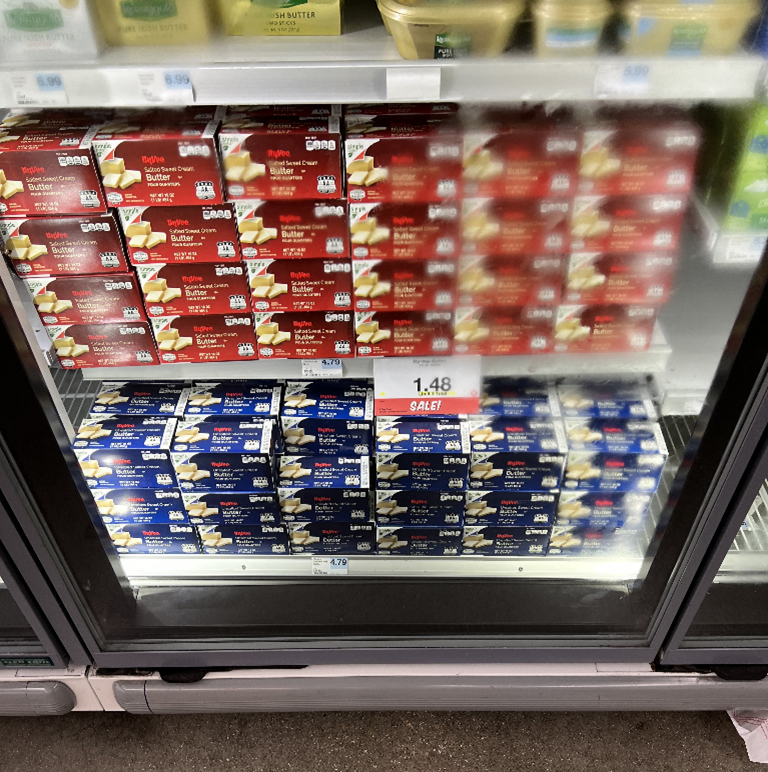Is there really a butter shortage? While some news reports may suggest otherwise, the answer is no—there is not a butter shortage.
While there isn’t a shortage, the U.S. is experiencing tight stocks, prices that remain elevated, slightly lower production than we had last year, and higher exports of butter. Competition for butter is high, too. All these factors together mean prices are likely to remain elevated through the holiday season and supplies will remain tight compared to last year.
How did we get here? It comes down to supply and demand. There is 22% less butter in storage in October 2022 than there was in October 2021 (USDA). Butter also costs 24% more today than one year ago (DOL). But neither of these factors equate to a “butter shortage”. In fact, they are linked—when there is less of something, it costs more. It also means that buyers will scramble to get their hands on butter—and possibly more than they need—before their neighbor or competitor. And media reports citing butter shortages only amplify that impulse, sending large buyers and individual shoppers into a frenzy. Grocery shoppers are not the only individuals out there buying butter. There are also buyers for grocery stores responsible for keeping shelves stocked and buyers for restaurants and institutions whose job is to make sure butter is on the menu. While prices are higher than last year, butter remains available.
Let’s look at the factors affecting butter.
- Butter Stocks: Butter stocks at of the end of August totaled 283 million pounds, down 22% year-over-year. That means we have less butter sitting in refrigerated warehouses waiting to go to retail or foodservice—but not a “shortage”.
- Butter Production: Butter production through August totaled 1.4 billion pounds, down 2.2% versus year-prior levels. Peak butter production season is now behind us.
- Milk Production: Demand for butter among U.S. consumers remains strong, especially at retail as inflation- and pandemic-formed habits have led consumers to prepare more food at home. Processors have struggled to increase butter production in 2022 due to lower milk production on account of rising feed, energy, and labor costs. Milk production was down 1% overall through the first half of 2022. However, we’re starting to see milk production grow in the U.S. and other major milk-producing markets after a slump in the first half of 2022. In the U.S., cream availability continues to grow to respond to a tight market.
- Butter Exports: U.S. butter exports through August were up by about 26 million pounds (approximately 40%). Americans are not the only buyers demanding U.S. butter—the world loves it, too, putting increased pressure on U.S. butter stocks heading into the holidays.
- Food Inflation: Reversing a decades-long trend, more Americans are turning to the grocery store rather than restaurants to fulfill food needs. The cost of groceries (food at home) rose 13.5% in the past year, the largest increase in 43 years. The index for dairy and related products rose 15.9 percent. For comparison—the average price of a gallon of milk is $4.41 today according to USDA, up from $3.37 in December, a 30% increase.
- Dairy Consumption Up: Even though Americans drink less milk each year, they are consuming more dairy overall. In fact, America’s per capita consumption of dairy grew by 12.4 pounds per person last year to 667 pounds of dairy per person overall. It takes a lot of milk to make butter. In fact, it’s a 20:1 ratio. And the average American eats 2 pounds more of butter per year than they did 20 years ago.
Altogether, the peak supply season is in the rearview mirror and the peak demand season is now upon us. Buter stocks are down, but we’ve seen bigger deficits before. Price inflation will continue to be the main issue for butter as we approach the holiday season. If you’re looking for peace of mind, the best bet is to plan ahead.
But a butter shortage? That is unlikely. This recent photo from one of our correspondents taken at a Midwest grocery story gives us all hope.



